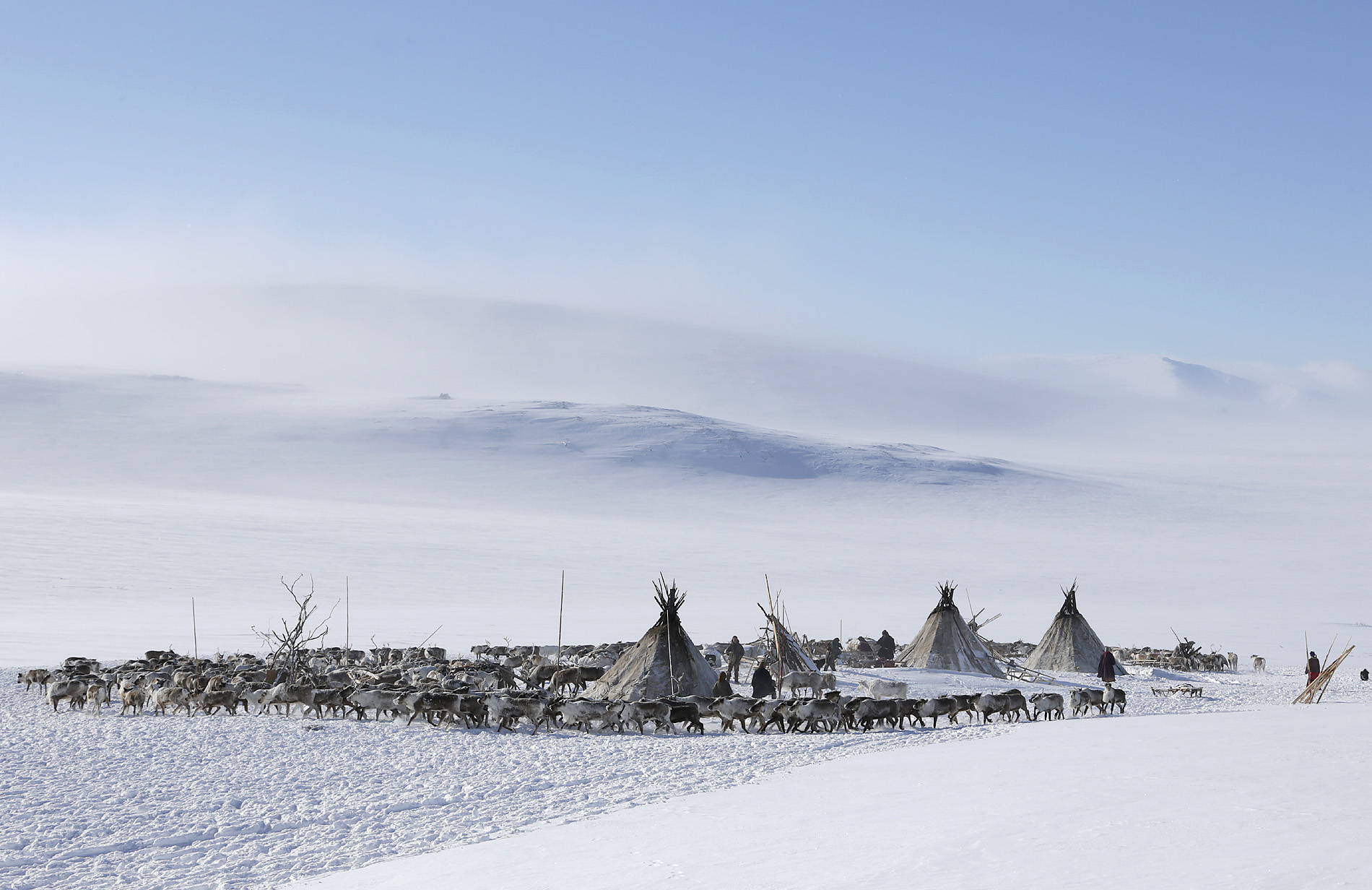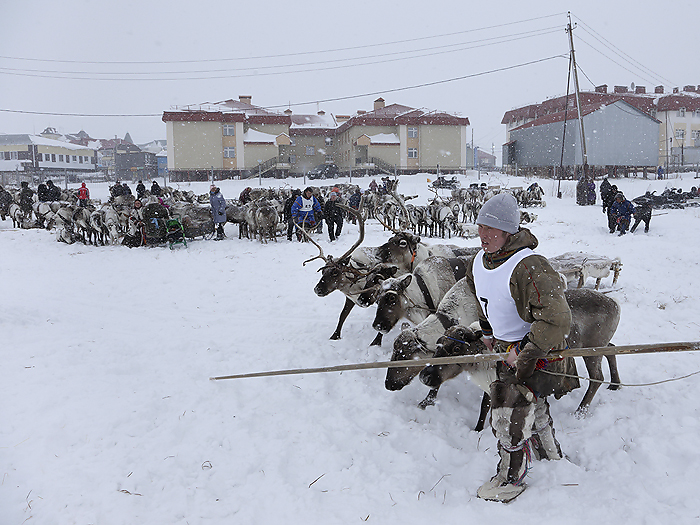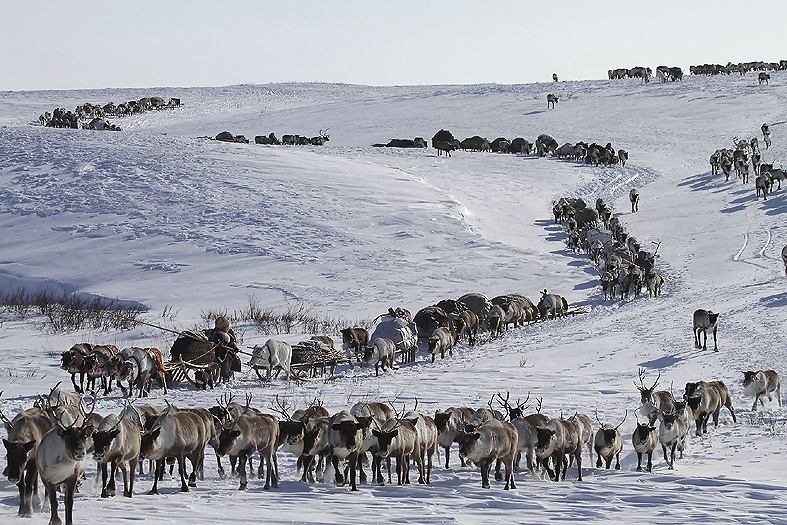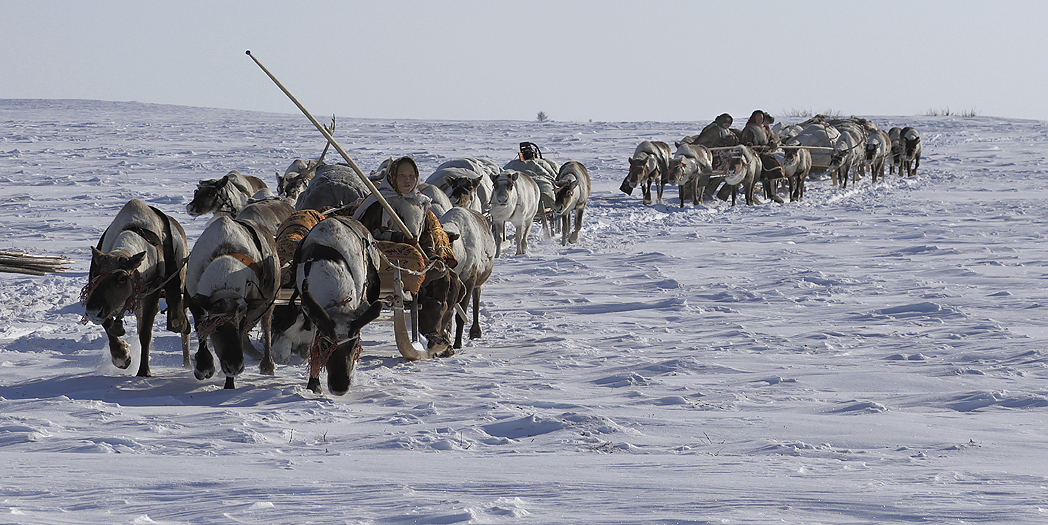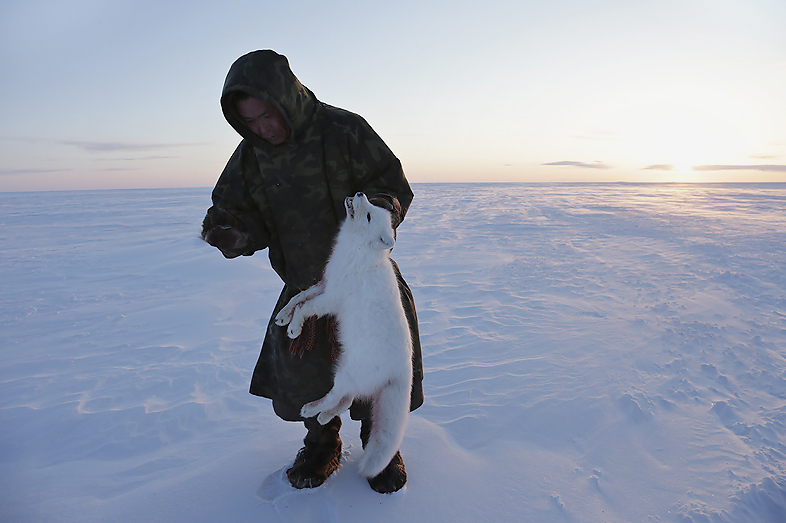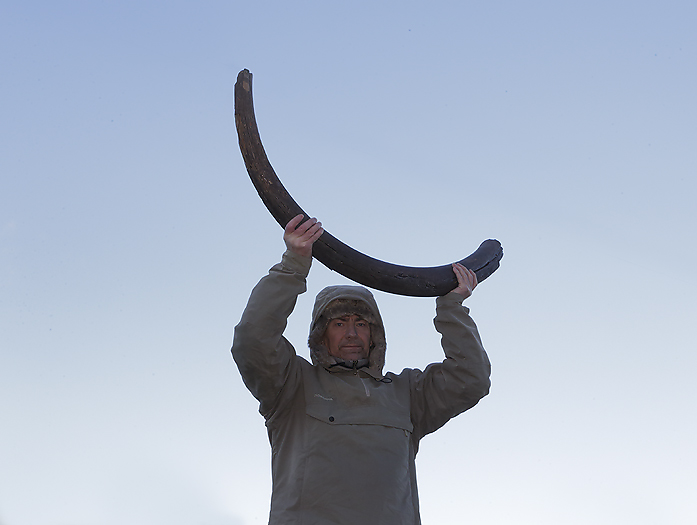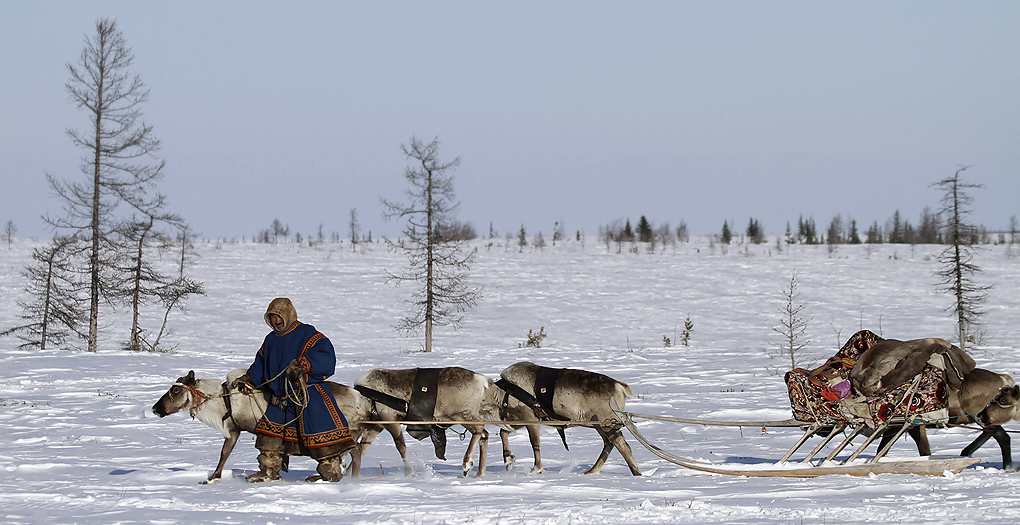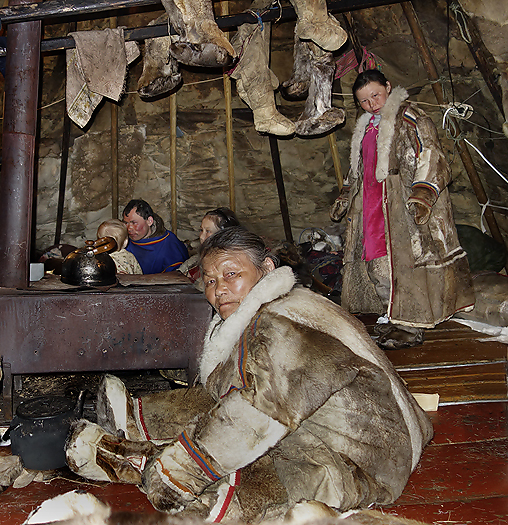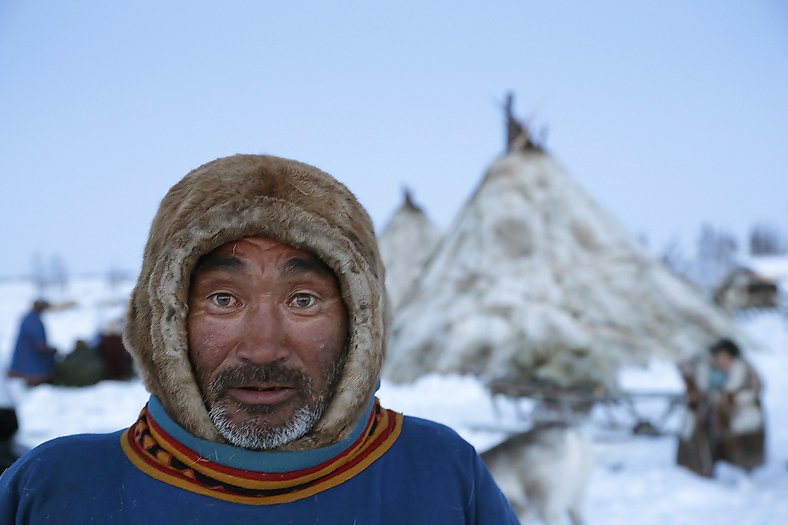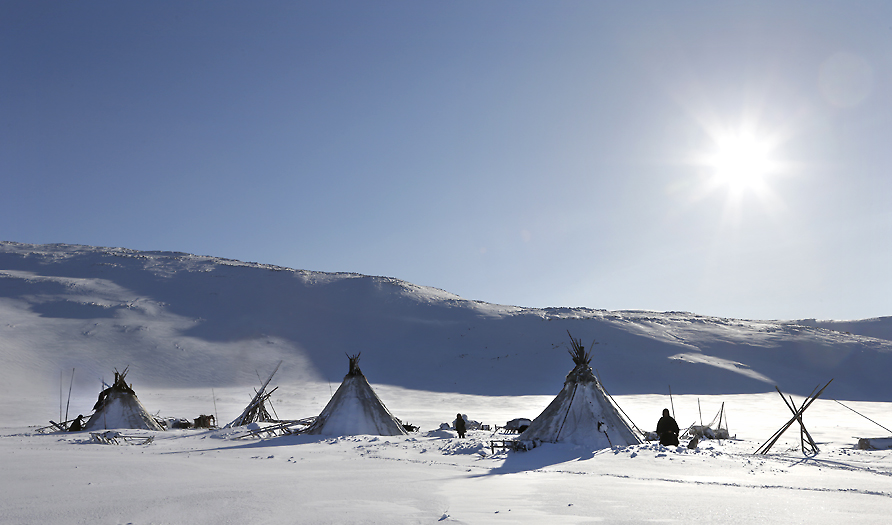Foreword
Changes,- the world today is not the same as the world yesterday, that is for sure. Development and modernization that for the last fifty years have taken place in a rapid way make us see that past generations had a very different way of living than most of us have now. This for both good and bad. The speed of this process have not been the same over the world, and are most noticeable for people that until recently have lived a traditional lifestyle (I.e. indigenous people).
The Russian indigenous Nenets people are the most traditional living arctic people on earth where the majority still live as the always have done. The purpose for this journey is to experience and document their way of living.
These people are first time mentioned in writing in Nestor’s chronicle from the year 1096.
The Nenets are reindeer herders living in the old world from the Kanin Peninsula in the west to Taimyr in the east. They are true nomads that migrate together with their reindeer herds year round. What makes them unique and true as nomads is that their migration includes all parts of the family; children, wife and parents/grandparents. This is especially valid for the Nenets of the Yamal Peninsula (“Ja’mal” in nenet language means “The end of the world”). An overview over their yearly migration cycle can be as follow: From January to mid March when the winter is as its coldest and the weather roughest they spend their time in their chums on the forest tundra (the transmission zone between taiga and tundra) in the Nadym region south of the Gulf of Ob. In these good reindeer feeding grounds they do not move camps very often, but stay behind and do work such as making new sledges, tools, necessary maintenance of equipment etc. Temperatures can also there easily drop to minus 50°C at this time of year, but it is far less windy than on the tundra further north. From mid March to beginning of June they migrate with first crossing the Gulf of Ob, for so continue migrating northwards on the huge Yamal Peninsula. Averagely they move camp every 2-3 days before reaching the Yuribei River halfway up the Peninsula. This big river must be crossed when the ice is still present, and they are therefore in a rush to reach there before the river ice breaks up. Grandparents and all winter equipment are left behind just before crossing the river. The Grandparents will stay at this place all Summer and support themselves mainly by fishing. With lighter equipment the younger generations head northwards with the reindeer herds. The sledges which are pulled by reindeer are used all year round and are now gliding on grass. The speed is slower, but goes remarkable smooth afterall. Making a huge circle up further north all Summer for finding good pasture land for the Reindeer they are back again to the newly frozen up Yuribei in October month. They pick up their Grandparents and head south again on snow covered tundra towards the Gulf of Ob that is crossed in mid December. The migration circle is closed when putting up their Chums (tepee-like fur tents) /winter camp in the forest tundra of the Nadym region south of the gulf in early January.
Some of the Nenets, -those with the longest migration routes can travel up to 1000km northwards, and the same distance back south again later in the year.
The travel.
It is beginning of April month in the year of 2013. The plane depart early in the morning from Moscow’s airport Domodedovo to the city of Salekhard north-east of the Ural mountain range. Already on the plane it is easy to see that we are travelling to the outskirt of the modern world; people with weathered faces and clothes amongst the passengers consisting of more fur than usual are worn.
After an hour in the air, the Ural mountains show up on the left side. This 2500km long mountain range which stretches south to north divides Russia from Europe to Asia is one of the oldest mountain ranges in the world. The east side of these mountains have always been characterized as extremely remote and difficult to travel to. Though not so difficult nowadays..
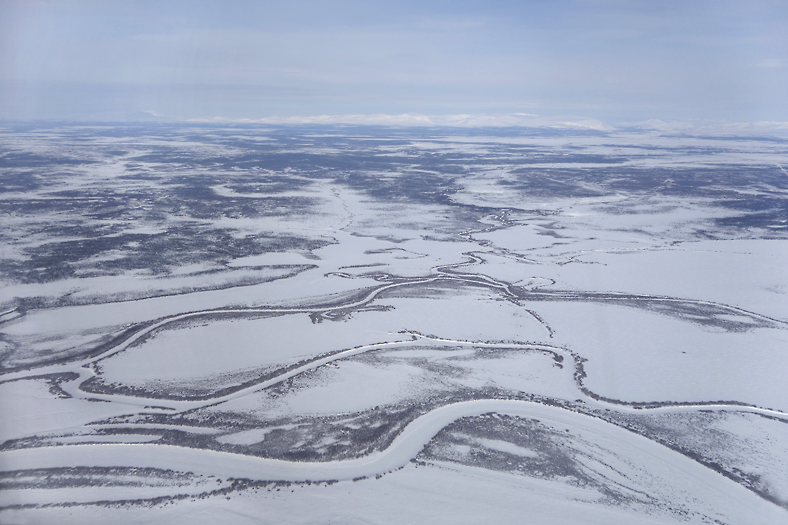
The taiga east of Ural, the Ob river in front, and the Ural mountains in behind.
Salekhard is the administrative center of the autonomous Jamalo-Nenetsk okrug, and is the natural port to the huge taiga and further north the tundra.
Some hours later we arrive Salekhard airport. After having been thoroughly controlled by security personnel and once again shown the stamped & signed permit from the Russian FSB (“Federalnaya Sluzhba Bezopasnosti”: Federal security service). The place here have for a long time been a so called “closed area”, and was until recently very difficult for foreigners to visit. Finally we can walk out to the fresh and cold Siberian air.
This was the easiest part of the journey, – from here we will have to travel north to the tundra by different kinds of transportation.
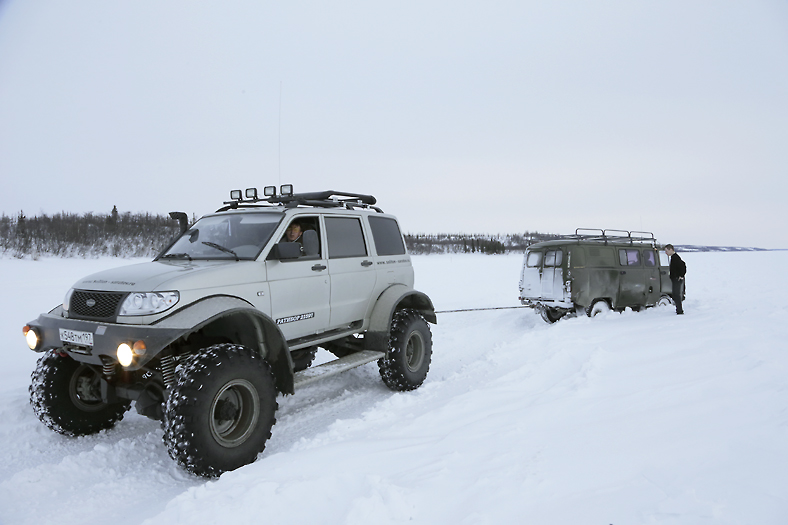
It is mandatory to help people that are in trouble out in this cold wilderness. Here we give help to people get loose a military vehicle that is jammed in the snow. During the cold war there were military activity at Salekhard, -this due to the location of one of the radar stations that once was the Russian answer on NATO’s DEW line (“Distant Early Warning”) against “enemy” nuclear missiles. No photographs of this station is taken due to, -hm…
After a 180km drive on the frozen and snow covered Ob river (no ice road) by customized vehicle we arrive the village Yar-Sale on the Yamal Peninsula close to midnight. The absolute majority of inhabitants here are Nenets.
Early April is also the time for the annual Nenet Festival in Yar-Sale. Nenets from all directions come to this festival to meet, compete and perhaps also find a future partner. This festival is very important for the Nenets and if they are available they really struggle to come to the village here.
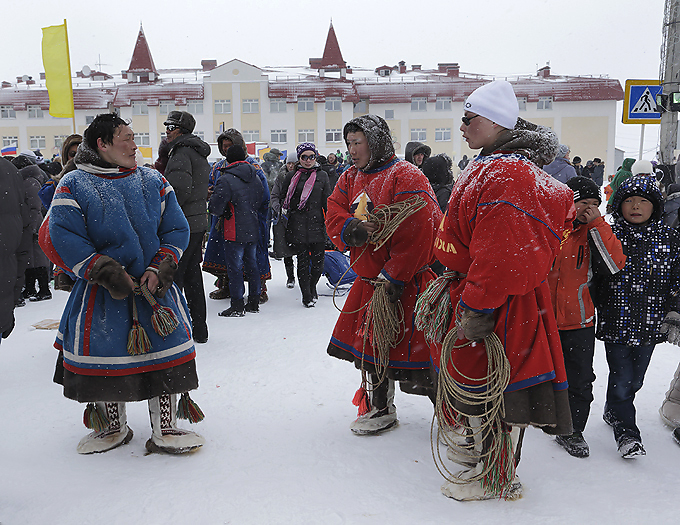
Tynzhang competition in Yar-Sale. New fresh-colored felts cover the reindeer coat.
Before heading further north out on the tundra a couple of nights is spent together with a hospitable Nenet family in their wooden house on the outskirt of the village. Some of the Nenets already have changed their lifestyle from the nomadic way of living to the more fixed life in a village (many of them shed tears of loosing their traditional way of living).
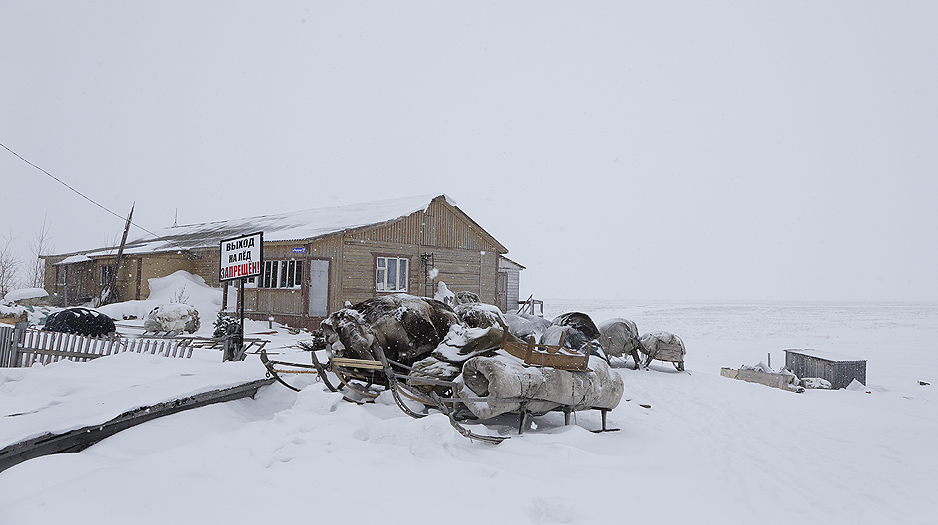
Nenets wooden house in Yar-Sale.
Joining the nomads on the tundra.
The plan is to join the Nenets on their spring migration after they have crossed the Gulf of Ob from south to north. There have been bad weather for some days, and when it calms down we finally set out on the tundra. It is quite a long trip out on the flat “endless” land of the Yamal Peninsula before we close in to the camp. As other arctic indigenous people it is fascinating to see how they manage to navigate without compass or GPS, -and they always find their way to the final destination. Regarding this trip we finally see the camp in far distance as two chums rise above the horizon. We’ll soon enter another world compared to where we come from..
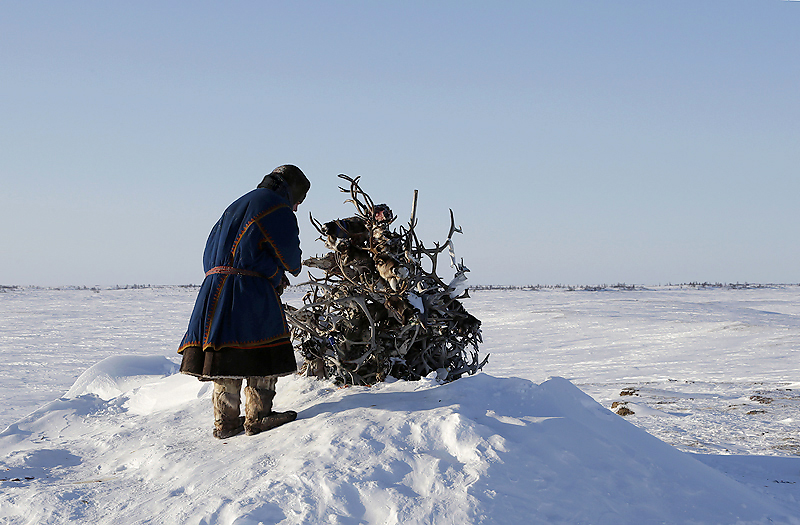
A mandatory stop at one of the Nenets sacrificial places. These holy places are spread over the huge Yamal peninsula and are still in use. Quite a number of the Nenets still practice the ancient nature religion. The power to the spirits in their natural religion are very strong, and it is said that if no offer is given when travelling beyond these places, bad or tragic things will happen (sickness, break down of sledges, problems during the autumn reindeer slaughter etc.).
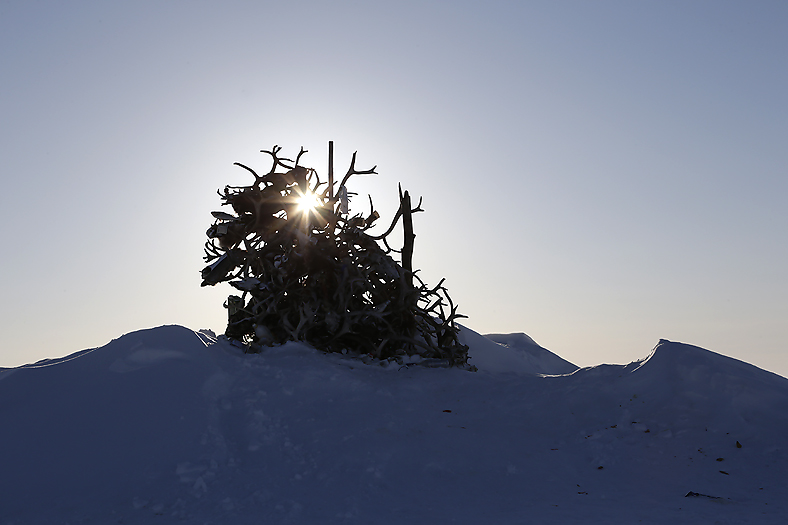
It is midnight when we arrive camp, but due to the high latitude, the nights are not dark. We are very well received -my Nenet travel companions walk around in the camp and says hello to their family members with happy reunions. Later we enter one of the chums, undress from the warm and heavy outer fur clothing and enjoy a tasty meal consisting of boiled reindeer meat and warm tea.
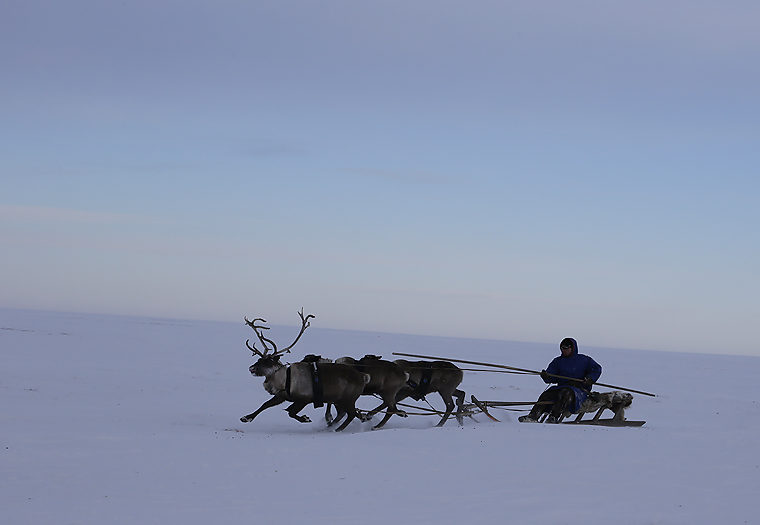
Out on the huge Yamal tundra in late evening.
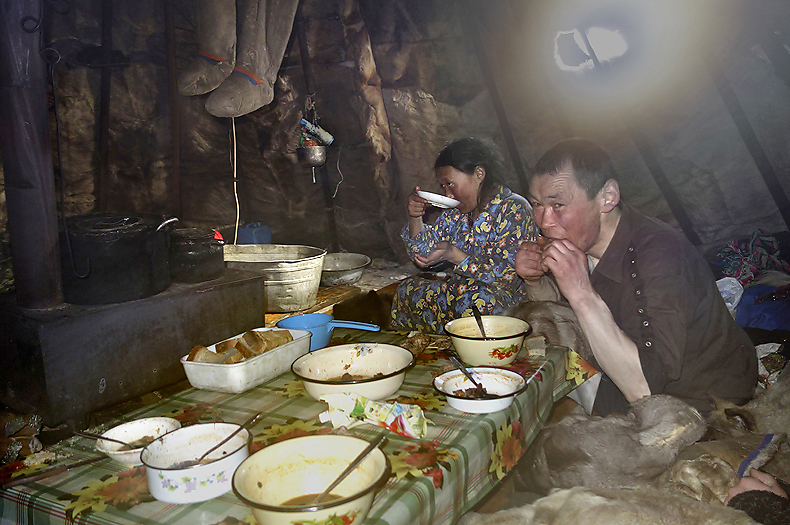
Bread and Reindeer meat in Chum when we arrived at midnight.
The Nenet society is built up of clans with families. The families in this two chums camp belong to the Serrotetto clan. Other clans on the Yamal peninsula are i.e. the Khudi clan and the Yaptik clan. The latter is the most powerful of the clans. The family I will join into on my first period here at the Yamal peninsula consists of husband Radik, wife Sveta and their 10 year old daughter Ulya. Most Nenets have both Russian and Nenet names, where they normally use the Russian names. For this family is Radik and Sveta Russian names while Ulya a Nenet name.
For not letting their Norwegian guest freeze they insist to dress me up in their traditional clothing. Which mean reindeer fur from top to toe. The most important is the footwear: Two layers of long “boots” where the fur is turned inward on the innermost layer and outward on the outermost layer. A special type of grass are placed in the bottom of the innermost layer. The footwear are quite long and reach well up on the thighs. They are held up by a rope arrangement on the waist. Stockings must not be used. This footwear are used day and night. Every second day it must be taken of and dried. A big fur coat (no zipper/buttons) with attached mittens are worn. This coat (russian: malitsa) are covered on the outside with a protective layer of felt (often colorized, -or camouflage patterned). The felt is used for keeping the reindeer coat clean for longer durability. A dirty coat is not a warm coat (women`s coats are not protected with felt). When the temperatures are below -40*C they use a second fur coat (russian: gus) as an outer layer, (December – March months), -there are no felt on this “gus”.
My experience during the period with the Nenets are that the footwear is fantastic, barefoot in the footwear in -30*C is absolutely no problem. Nor the malitsa in this temperature, – perhaps a bit heavy and a little troublesome when working with the photographic equipment documenting the Nenets way of living.
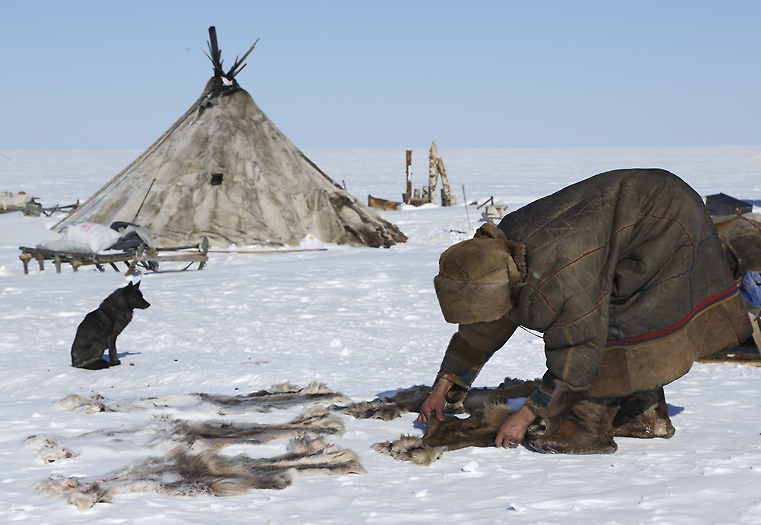
Sveta prepare fur for footwear (only the fur from the forelegs are used), except for the sole that is made from the reindeer’s head (between nose and forehead) which are extra durable due to wear from the ground.
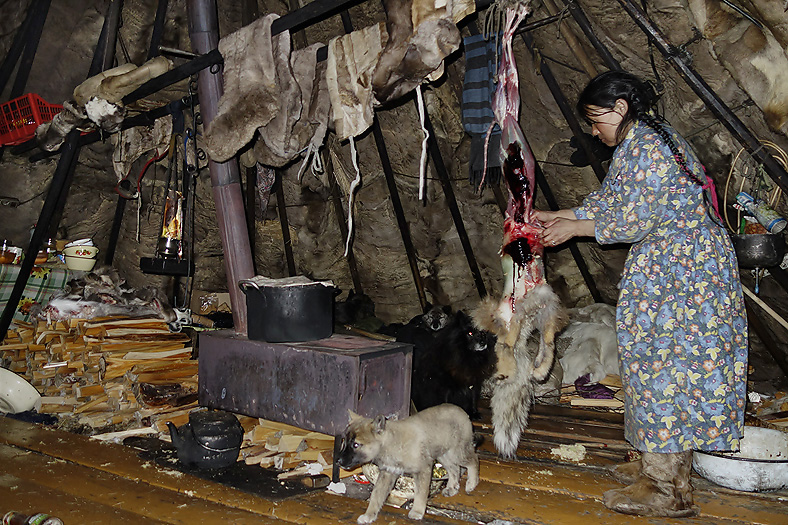
Footwear hanging to dry in the chum.It is forbidden (taboo) for women to use men’s fur footwear. Here we see Sveta flay a Red Fox.
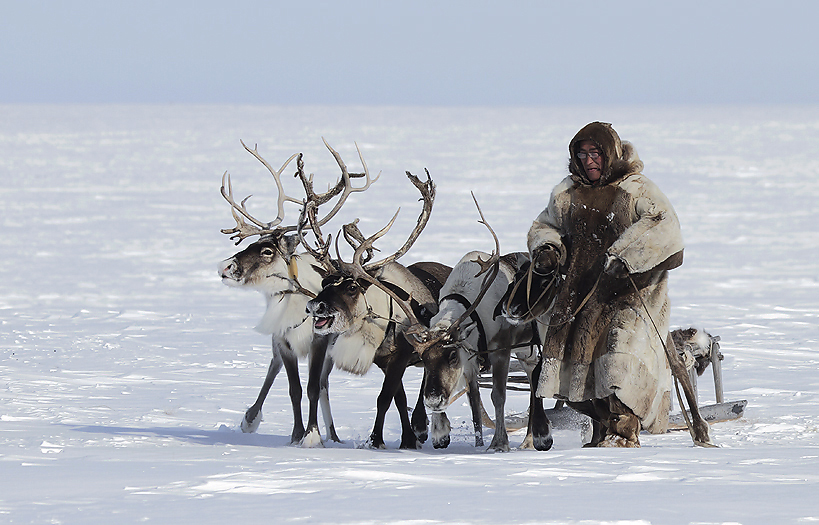
When travelling over long distances, or in really cold weather, the Nenets use a second layer of Reindeer coat, named”Gus”.
Herding.
Approximately half of this family’s reindeer herd are at the present 4-5km away from the camp. For having better control on them and as a preparation for migration northwards Radik says that they soon will drive them to the camp. The next day we head out from the camp to find the reindeer. After looking on the animals in his herd to check that they are OK, we start to drive to the camp.
As you perhaps begin to understand: For the Nenets it is all about the reindeer. All. The reason for their reindeer herding in general is not about money, but for food, clothes, tents etc. Trading at the existing trading stations is only about getting a little extra from the modern world.
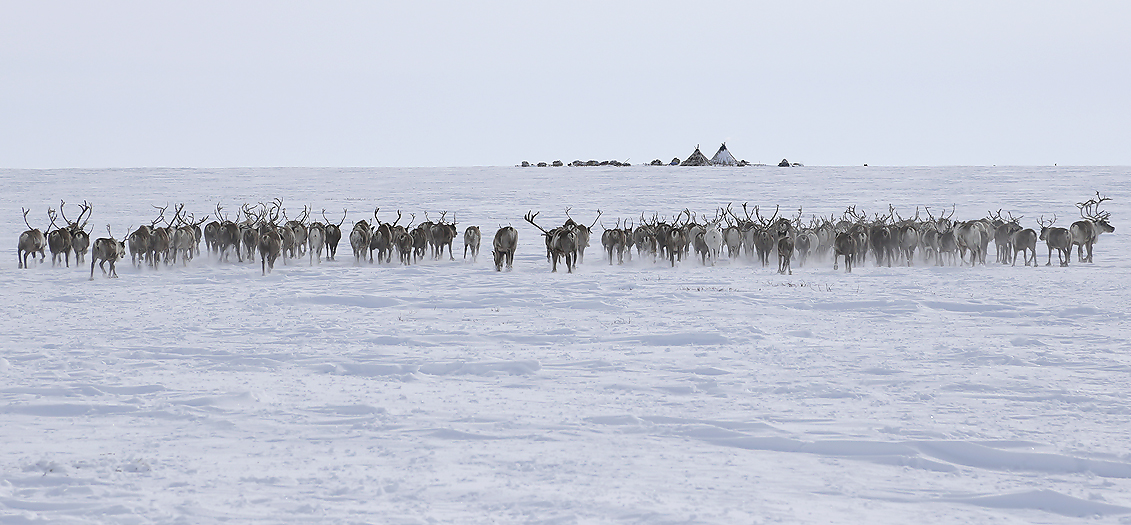
Part of the herd on its way to the Nenet Camp.
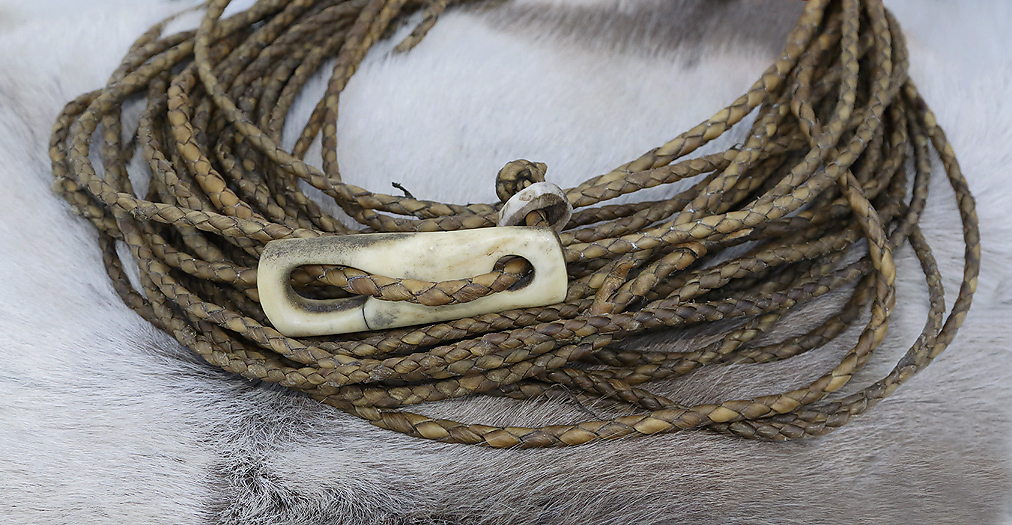
Lasso, or direct translated from the Nenet language to: “reindeer catcher” (Nenet: Tynzhan) As for the inuit`s ulu, -the Tynzhan is very valuable and passes on from father to son. The Tynzhan is made of raw, twisted reindeer skin is the herders most important tool. Following the tradition the length of the Tynzhan must be as for 18 stretched out arm lenghts. The fittings attached are normally made of reindeer bone.
The rest of the reindeer are mixed into another reindeer herd some 10 km away. This big herd are very close to another camp with Nenets from the Serrotetto clan. We go over there and Radik and people from this camp start to separate the reindeer. 4-5 hours later a herd of 200 reindeer are separated by 6 Nenets in action. The reindeer catcher (tynzhan) are used all time under the operation. The separated reindeer are made immobile by tying two legs on each animal together. When this are done, the untied reindeer are driven 2-3km away. Then the tied one are released and they are driven against my host-family’s camp.
As we drive the reindeer towards the camp, the wind is increasing and the visibility are decreasing. It is obvious that a bad weather system is coming in. After two hours we are “home” in camp. Warm tea and raw reindeer meat are served (ribs) by Sveta inside the chum. Outside it is gale wind and -20*C. during the rest of the day the wind is further increasing.
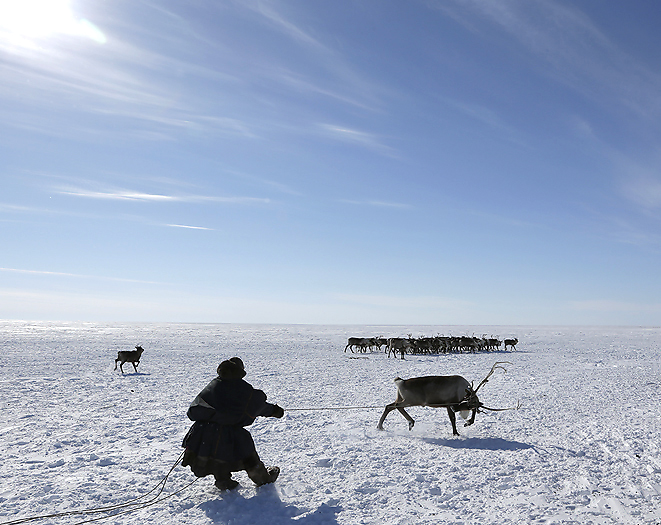
The Nenets are held to be the best reindeer herders in the world.
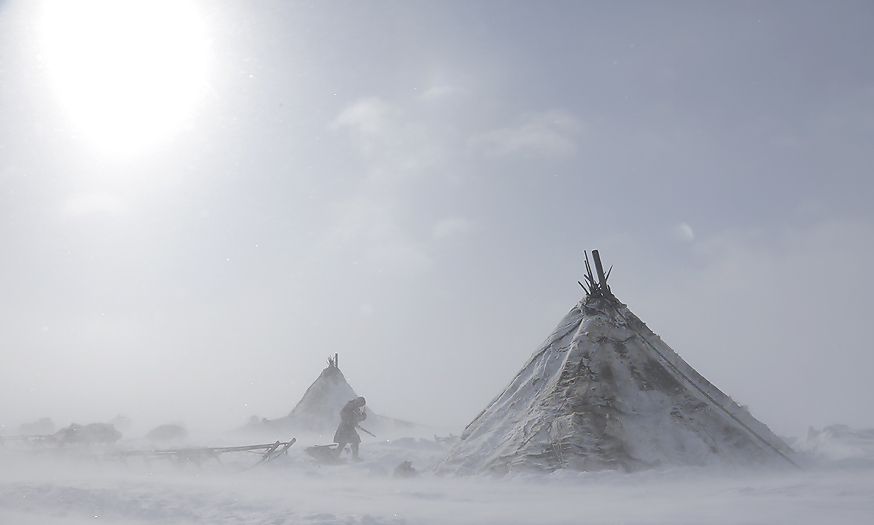
The huge Yamal Peninsula is very flat, -causing strong winds with drifting snow in a moment.
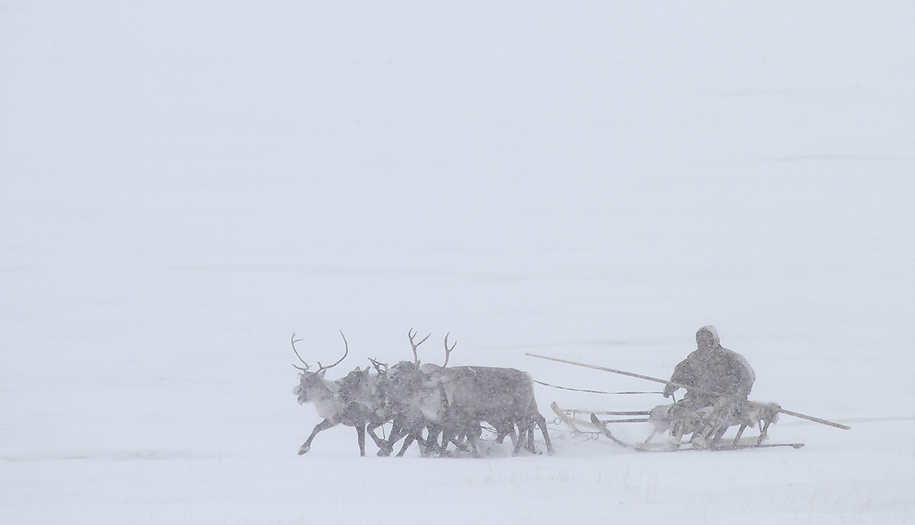
As other indigenous People, the Nenets have no problem setting course and find their way in weather with low visibility (without using Compass or GPS).
Before heading further north, Radik says that he need to go to a sheltered special place on the tundra were there are trees they can cut and bring with them as firewood for their iron stove inside the chums. There are also an old Russian trading station at the place that the Nenets some times use. Here they get i.e. biscuits, bread and something sweet to the children.
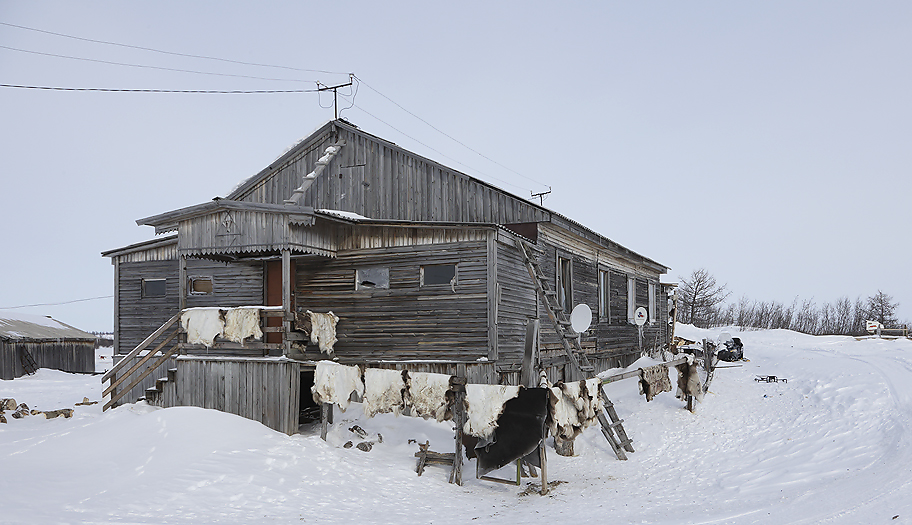
The old Russian trading station at Portsa Yakha.
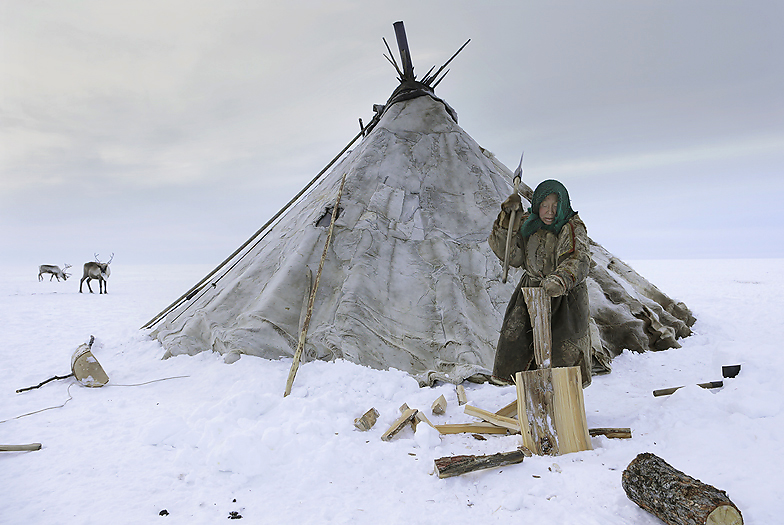
Firewood are extremely valuable for the Nenets, they have to bring a heavy load with them on their migration at the treeless tundra for cocking and heating of the chums.
The migration.
Another step of the migration have begun. Long rows of reindeer and reindeer pulled sledges moves calm and determined northwards on the tundra. Each family have 12-15 wooden sledges that carry all their belongings. 4 or 5 of them are often tied together where the first one is controlled by a Nenet (normally a woman) with a long wooden stick. Each transport sledge (Nenet: argisj) is pulled by between 1 to 4 reindeer. The sledges have different names after what is transported on them (i.e. pi-han with firewood, larj-han for food, luhuna for clothes and “fur-linen”, vandako for outerwear and fur).
The men herding the reindeer must travel in lighter and more maneuverable sledges (Nenet: khasava-han).
This arctic caravan with all family members migrating with all their belongings is an amazing and very exclusive sight nowadays. As earlier mentioned it is only the Nenets on the Yamal Peninsula that still does this the authentic and traditional way.
The caravan move near noiseless on the tundra. All sledges follow each other on a line in the same tracks. The reindeer herd itself often walk beside the row of sledges, – near forming two parallel caravans. They are always in a hurry, even that it normally does not look like that, -to reach the grazing land in the north before the ice on the rivers break up in June month.
The most frequent wildlife to be seen on the tundra here are the Rock Ptarmigans, – they are often seen feeding on low wind swept ridges. Their plumage are pure white, so they are normally seen when we come at close range. Both Red Fox and Arctic Fox are present, the Red Fox are dominant and more aggressive, and with the milder climate that have occurred the last 10 years they have taken over areas that earlier was Arctic Fox land. Wolves are also present, but not in big numbers (there are around 500 of them at the Yamal Peninsula). Bears are also present on the tundra, and together with the wolves they are a kind of holy species that are not hunted. When these animals kill reindeer for food, they are allowed because it is god’s will.
Thousands of years ago the Yamal Peninsula inhabited great numbers of the Woolly Mammoth. Every year the Nenets find remnants of these former rulers of the Yamal Peninsula. In May 2007 the Nenet reindeer herder Yuri Khudi and sons found the near intact, mummified body of a young Mammoth at the Yuribei River. This mammoth was first sent to Salekhard (Russian “Mammoth Capitol”), and later to Japan for analysis. The world could see photos of the animal that was named Lyuba (after the first name of Yuri Khudi’s wife). Closer studies of Lyuba showed that she died 41.800 years ago. Last time a living Wolly Mammoth walked on the Yamal Peninsula was 10.000 years ago.
Radik, the man of “my host family” found 4 mammoth tusks last summer north on the Yamal Peninsula while herding his reindeer. He says that the most common way to find mammoth tusks is in dried out ponds were parts of them is sticking up from the soil. I ask him: “What do you do with these tusks?” And he answer: “Ah, -I have no use of them so I give them away to people I know that use this durable material to make certain crafts”.
Camps and routines.
The migration continues… And two hours after start it stops for the day at a suitable place with good reindeer pastures. Here is also one of the the last small forests to be found before the total woodless tundra takes over.
Maksim jump of the sledge and lead the reindeer closer to the place where the chums are to be set up.The sledges are placed strategically at the area planned for the camp, and the reindeer are released from the sledges and herded towards the huge main herd consisting of a couple of thousand reindeer. Four chums are set up on the snow covered ground. First of all the wooden floor (thick & wide planks) are put out on place, thereafter layers of interconnected birch branches, the iron stove are placed in, thereafter the low wooden table, “kitchen equipment”, and lastly loads of reindeer hides used on the floor and as “duvets”.
The chum are formed by first putting up long wooden sticks in a circle (approximately 10-12m in diameter at the base), -similar to the indian tepees. Thereafter huge sheets of stitched reindeer hides are raised up to the very top using other long wooden sticks. 4 of these sheets cover all balusters and form the chum. For keeping the cold outside, 8 more of these huge sheets are placed on the chum. The chum consist now of 3 hide layers. A rough calculation give the amount of 120 single reindeer hides per chum (!).
Finally, -snow is shuffled on the outside around the whole chum to prevent any snow to blow inside.
I logged the time for setting up and make the camp ready, it took 2,5 hours, something that is right on the average of this process.

Making camp for the night. Three images in sequence showing how it is done.
The chum is in practice split in two parts inside; storage area in one half and living/sleeping area in the other. The stove is placed in the middle.
A lot of activities take place inside; Eating, talking, storytelling, small children`s play, maintenance of minor equipment, making new fur clothes, preparing small hides for trading (fox, wolf etc.).
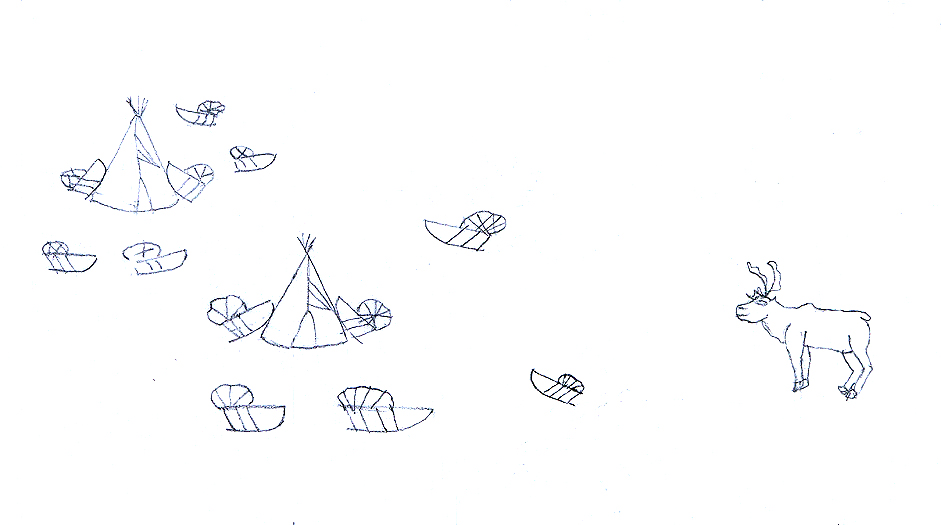
The children was told to draw what ever they would like to in the authors diary. Most all of them was about their daily life, -this was the most typical one. Drawn by 10 years old Ulya.
Since firewood are very limited to achieve, -the iron stove does not burn constantly when they are at the tundra (3 layers of reindeer hide as chum wall helps keeping the warmth inside).
When guests are visiting the chum, something that is quite frequent (other Nenets), -it is the wife’s duty to serve them until they either leave or go to sleep in the chum. The most common main meal for the Nenets are raw & boiled reindeer meat and raw & fermented fish and sometiimes Arctic Hare when they have to to hunt these animals.
The evening inside the chum ends normally around midnight, -if there still should be fire in the stove, this is let to burn out. People sleep directly on the floor (though on top of many layers of reindeer fur), with heads against the “fur walls”. The owners (husband and wife) sleep closest to the entrance, and guests innermost. Of this reason my sleeping place are innermost in the chum.
When all of us laid down for sleeping, the wife Sveta placed 3 layers of reindeer hides on top of each person. This is also part of the wife`s job. A bit heavy if you are not used to it, but they sure isolates well.
As normal, I am first person out of bed. I am first because the Nenets are not early up, -they enjoy the warmth under the hides as long as possible. Outside it is -25*C and frosty with fog and white icy trees. It is a beautiful morning and a pleasure to walk around and enjoy the place & situation I am in for these weeks.
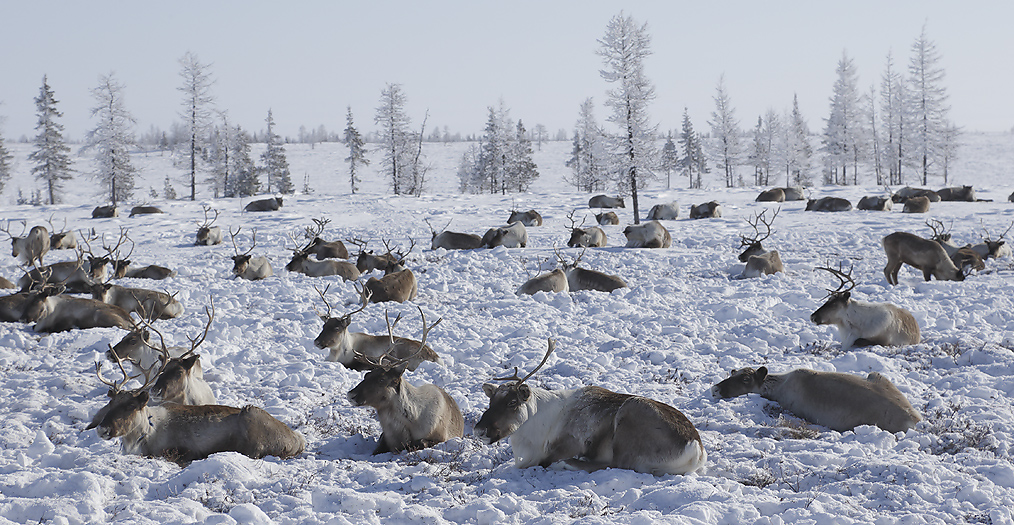
Next morning a small part of the reindeer herd rest beside the camp.
Around 11 o’clock the families are up, the stove burns and we eat breakfast consisting of warm tea, bread with butter & jam, and biscuits. General “Toilet routines” are so that the women go outside and do nr.1 in front of the chum, and the men on the backside. For no.2 both sexes go 100-200m behind the chum “until no one can see them”.
Afterwards the Nenets from this 4 chum’s camp gather together outside for talk and discussions.
Although here are good pastures with plenty of reindeer lichen, the Nenets decide that we shall move further on. This due to the good weather we have today. The distribution of work is so that the women, small children and the elders pack down all equipment in camp, while the men and older children go to the grazing reindeer herd and catch those that shall pull the sledges. These reindeer are not marked in any way, but it is no problem for the Nenets to pick them out and lasso them in among the in total 2000 reindeer. Both processes above take approximately 2 hours each.
A bit strange to think that the Nenets have to pack down their entire belongings in life every 2-3 day, every year (except for January to Mid March when they wintering south in the tundra forest south of the Bay of Ob).
Before the caravan begin to move, we have a light meal out in the free. it consist of frozen fermented fish, bread and biscuits.
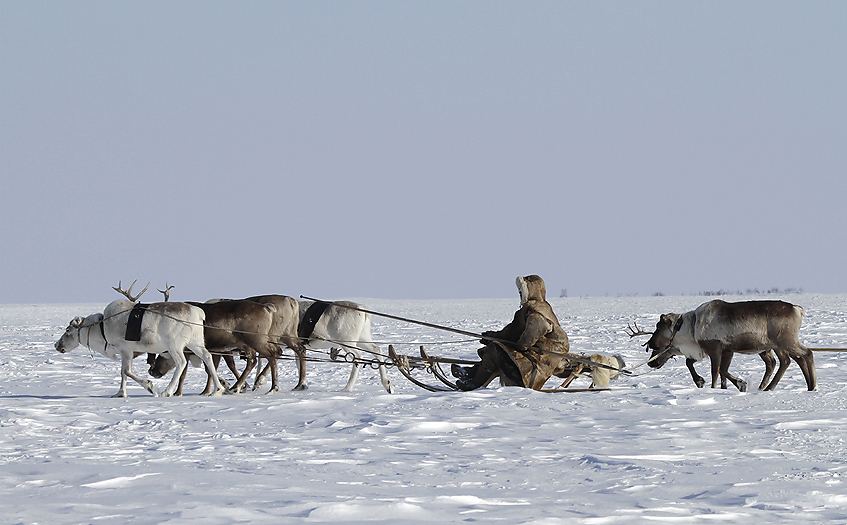
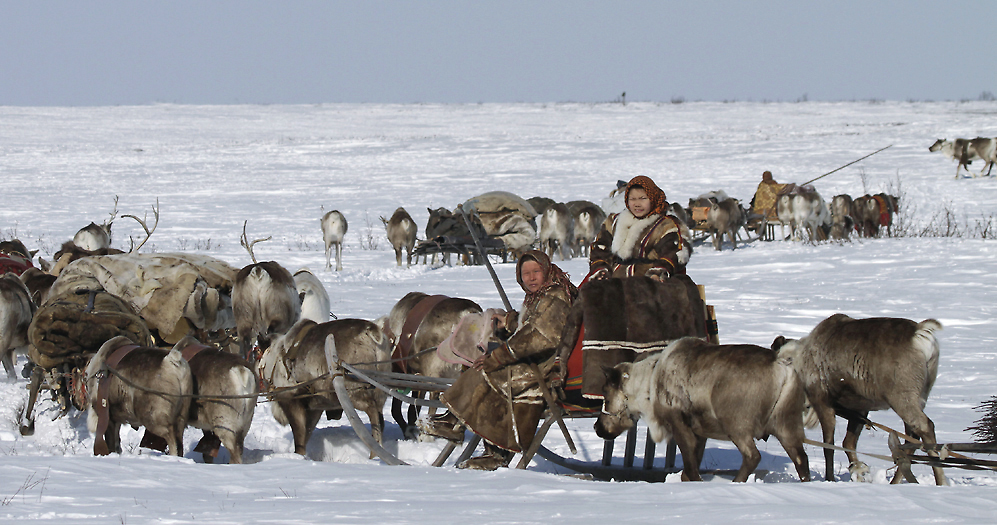
On the move again, -further north.
Against the Polar Ural mountains.
The migration continues northwards… Later on my journey I leave the Nenet herders on the Yamal Peninsula and set course westwards up in the Ural mountains. To be more exact, in the north part of this mountain range that is named Polar Ural. There I will join the Nenets living in another environment than the flat tundra of the Yamal.
The travel to The Polar Urals go via Yar-Sale and Salekhard. From Labytnangi I go by train deep into the Polar Ural mountains. On demand the train stop by the abandoned settlement of Polyarnyj. There are no railway station, so it is only to jump of beside the railway tracks. A minute later I see the back of the train driving westwards between the snow covered mountains. Next fixed stop for the train should be Vorkuta I believe. I look around and understand that this is not an ordinary village, -the old military vehicles that sticks up of the snow show that. This is the place in the Urals were the Soviets launched test missiles with nuclear war heads towards Novaja Zemblja in the Kara Sea.
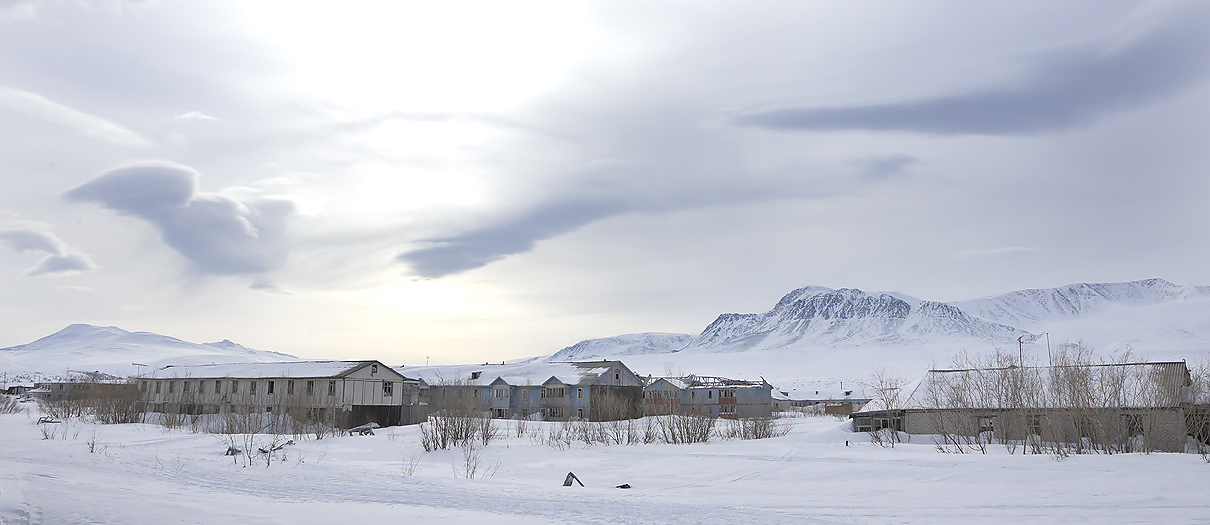
Polyarnyj in the Polar Ural mountains.
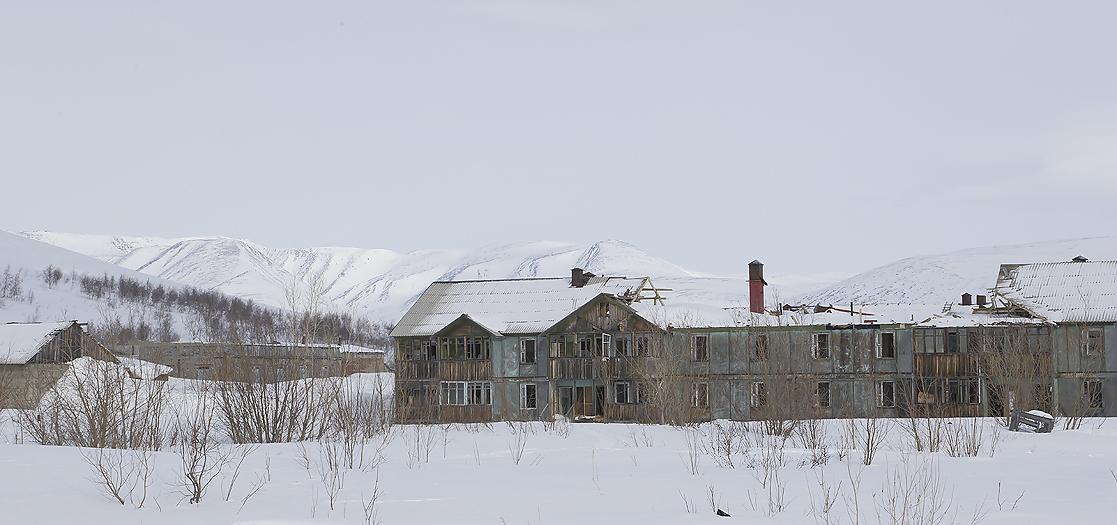
Part from the abandoned settlement of Polyarnyj.
Well, – the purpose with the journey is not to dig into old military matters so I continue further on to one of the very few buildings that are maintained and people can live in. Here I can cook food, have a shower and sleep until the next day when the plan is to be picked up by a Nenets that will bring me and my interpreter high up in the mountains were they have their camp for the time being. The Nenets in the Polar Ural mountains also migrate year around with their reindeer, but have another pattern than their relatives on the Yamal Peninsula.
Next morning the weather show that a low pressure system have arrived, – it is snowing heavily. So it is only to wait, the Nenet will for sure not pick us up in this weather. Well, – that was what we thought. A couple of hours later, it is still snowing, and quite windy as well, the Nenet Efim suddenly arrive and ask if we were ready. These guys are tough people and does obvious not fear a tiny snowstorm…
An hour later we are under way up the first hills at first between birch trees, holding a firm grip on the wooden sledge along the curved route. The visibility is poor due to the snow fall, and close to zero when coming above the treeline. We are underway for several hours, and while sitting in the sledge I wonder how the Nenet navigate in this landscape without any visible (for me) contours in the landscape. Both the present heavy snow fall, and also the total snow covered ground should after my opinion prevent any living soul to be able to navigate. Except for him, Efim, that after a couple of hours brought us directly to the camp. Impressive.
Arrived the Nenet camp in the mountains.
We were nicely welcomed of the people in this camp containing of 3 chums, with hot tea and bread/biscuits served us. We talked a bit ourselves (good to have an interpreter), and relaxed after the travel up in the mountains and due to the bad weather outside. The Nenets are a bit shy and hesitate a bit to open themselves. The Nenets in this chum were in fact Christians (catholic) ans very often they were singing/humming old christian songs. Later that evening I went outside having a look and tried to get an impression of how the landscape are up her, but still impossible, only the chums were pointing out from the white and hazy atmosphere.
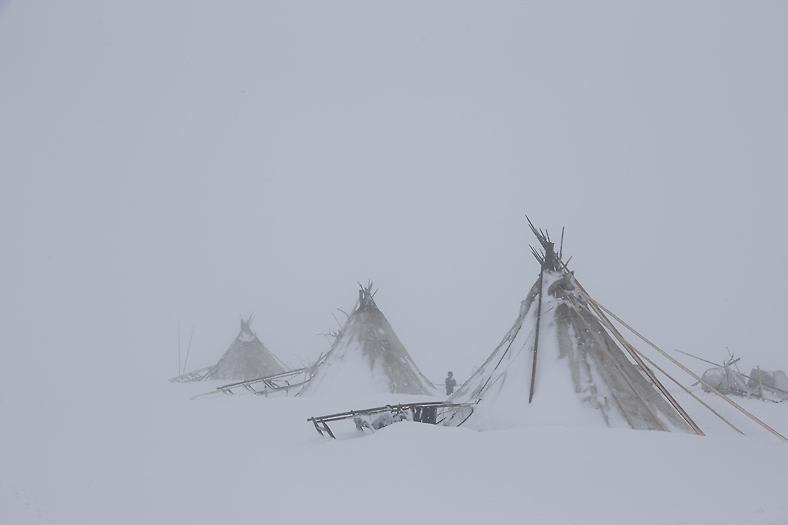
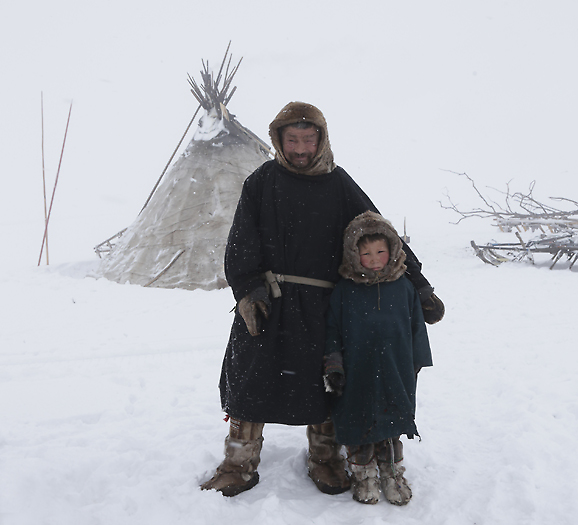
Nenet boy Viktor and Mikhail welcome us to the Camp high up in the Polar Ural Mountains.
The next morning I hear knocking sounds outside, and I look outside the chum to try to see what happens. When I put the reindeer hide aside from the opening, both strong light and cold flashes in my face. The sun is shining from cloudless blue sky and the mountain peaks are showing rather close, -it look extremely beautiful! As first person in the chum I dress up and go outside. Wow, -what a place the have placed their camp, innermost in an elevated valley which are surrounded with mountains on 3 sides, and a wooded greater valley far below on the fourth side. A little mist here and there makes the scene amazing. The knocking sounds I heard came from the neighbor chum were the Nenet Larissa remove the snow from the chum using a special wooden “snow remover stick”, but due to her shyness she soon go inside the chum. Her father Mikhail are also outside and brush the snow away from their sledges & other equipment after the great snow fall yesterday.
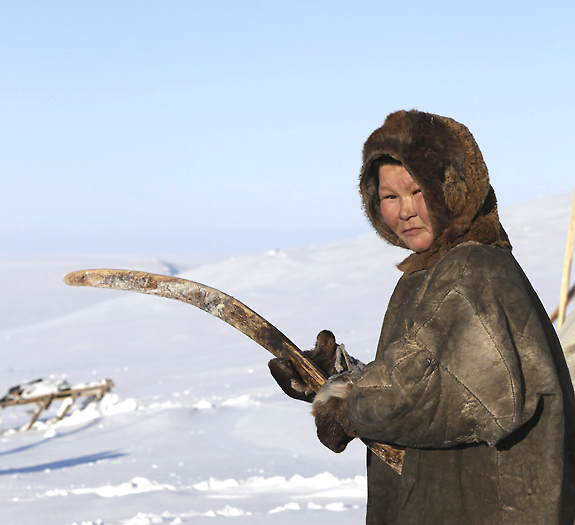
Next morning Larissa use a special Snow-banker Tool to remove the Snow from the Chum.
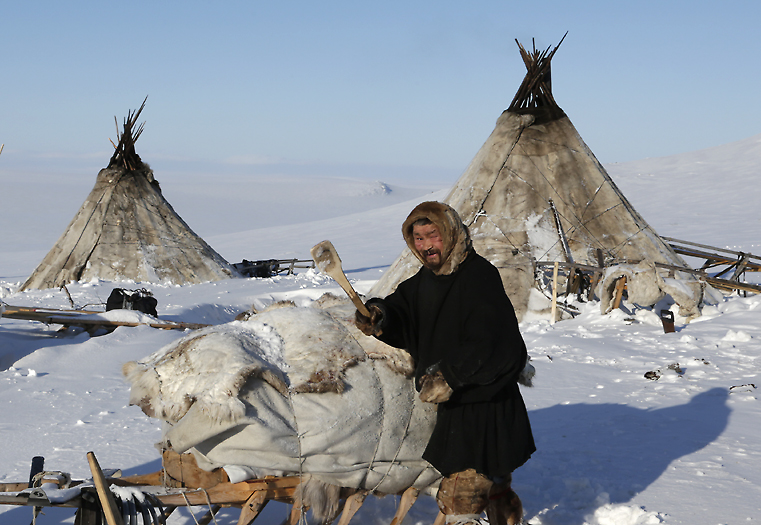
Also Mikhail use a special wooden Tool for removing Snow.
The Nenets in this camp belongs to the Laptander clan and as earlier mentioned travel year around with their reindeer herd. During the snow rich winter months they normally have their camp high up in the mountains to be close to their reindeer herd that can only find food at elevated areas that are wind swept for snow. In addition to this, they also need to be close to the reindeer because of the wolf threat in these remote mountains. The Polar Ural mountains are as we understand the northern part of the Ural mountains, and stretches about 500km in north/south direction. The highest peak is Mount Mayer , 1472m above sea level. We cannot see it now, but these northern mountains are very weathered with huge areas of frost eroded rocks. The surrounding wildlife to mention are Brown Bear, Wolf, Wolverine, Red & Arctic Fox, Marten (in the lower parts of the mountains), Golden Eagle, Gyr Falcon, Rock Ptarmigans and Raven. Since we still log April month, non of the migrating birds have arrived yet, except for the Ravens that just have arrived.
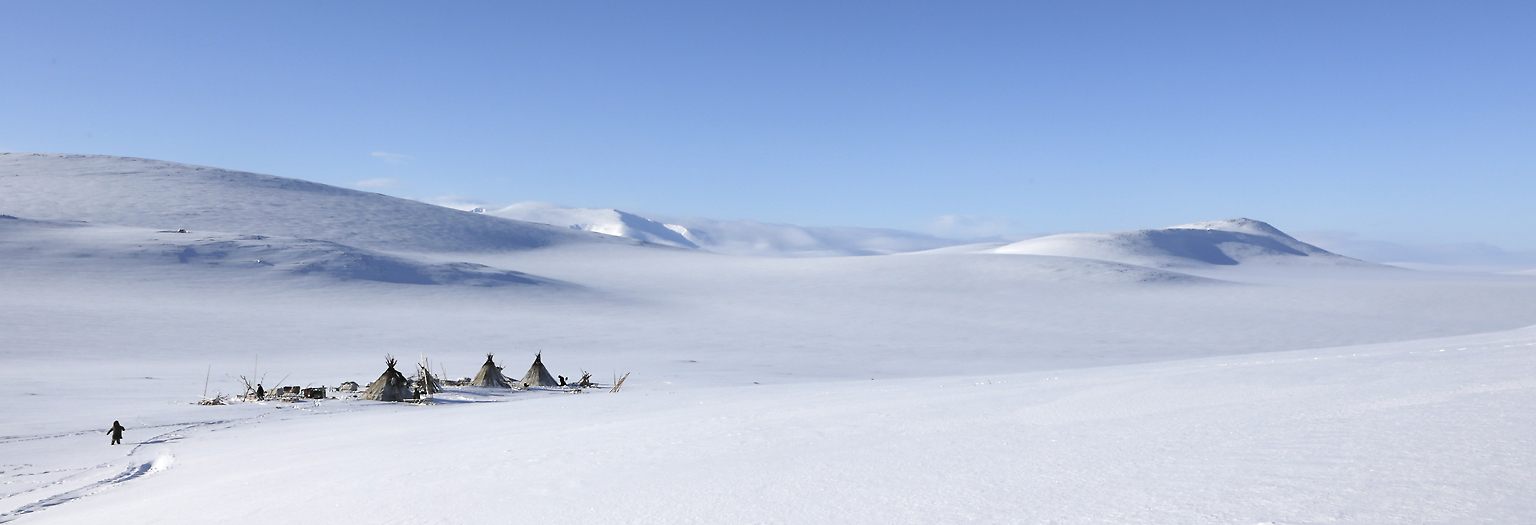 The Nenet Camp in the Polar Ural mountain range.
The Nenet Camp in the Polar Ural mountain range.
To trade for valuable food supplies as bread, biscuits and sugar the Nenets get some income from Fur trapping (mainly fox). It is very interesting to follow the daily life of the Nenets, and I spend most of the day outside, well dressed, and the -25*C does not feel as cold as one should believe.
Due to the bad weather yesterday the Nenets did not do their daily check of the reindeer herd. They are therefore very keen to check them up as early as possible today, hoping for no losses to the more or less present wolves. Mikhail harness up 3 reindeer and set course further up in the mountains.
In the mean time Efim and Maukyn do necessary maintenance work on their equipment. Hard & tough life with much use of equipment makes maintenance always necessary.
Later in the morning we suddenly see the reindeer herd running down the hillside beside the camp, with Mikhail on his sledge behind. He leads the herd directly to the camp. As they approach us we hear the characteristic clicking sounds from the reindeer legs. The reindeer must be quite familiar with the Nenets because they calms quickly down around the chums. At first sight no one seems to be hurt at least.
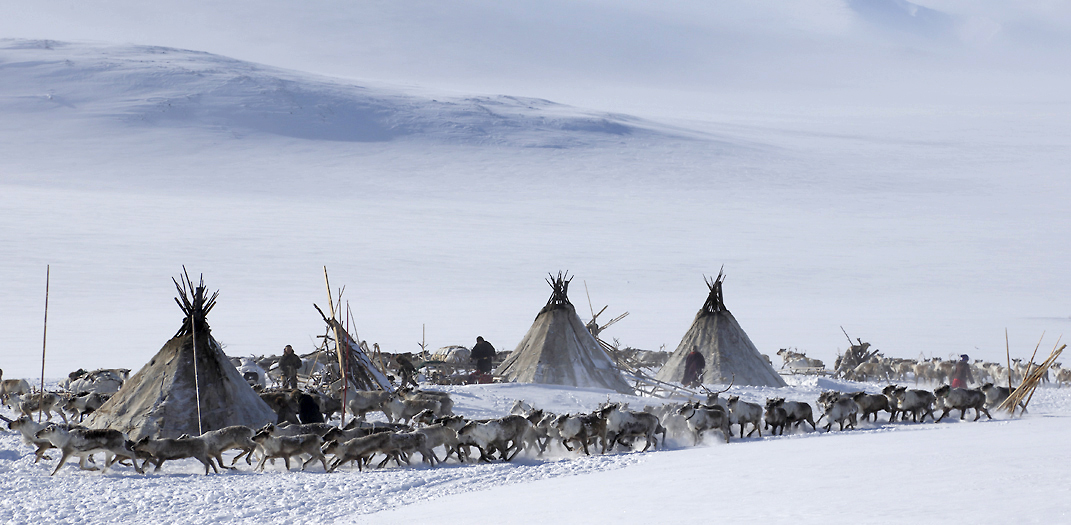
The Reindeer Herd has just been brought down to the Camp.
The Nenets in the camp are short of meat so they select on of the reindeer in the herd and catch chosen one with the reindeer catcher. Typically for indigenous people they strangle the animal to death. Before the reindeer cool down and freeze the hide is split open in the animal’s fur is opened lengthwise in the stomach and pulled of by force. All people in camp surrounds the animal that is opened up to expose the entrails. The kidneys which are the most sought for organ, are cut in pieces and eaten at once. Warm blood is also drunk at once (added some salt to get it more tasty). The rest of the animal is quartered and stored in the “Larj-han” sledge with its characteristic wooden container on top (which looks in fact look more like a coffin, but is a natural freezer). The Nenets are the arctic people that are most dependent on reindeer, and absolutely all parts of the animal are used (for food, clothes, tents, tools, seizures etc).
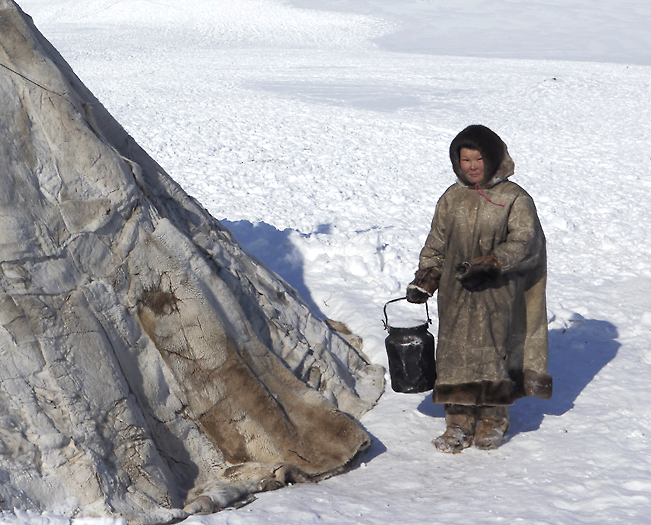
Larissa bring water collected from a Spring under the snow.
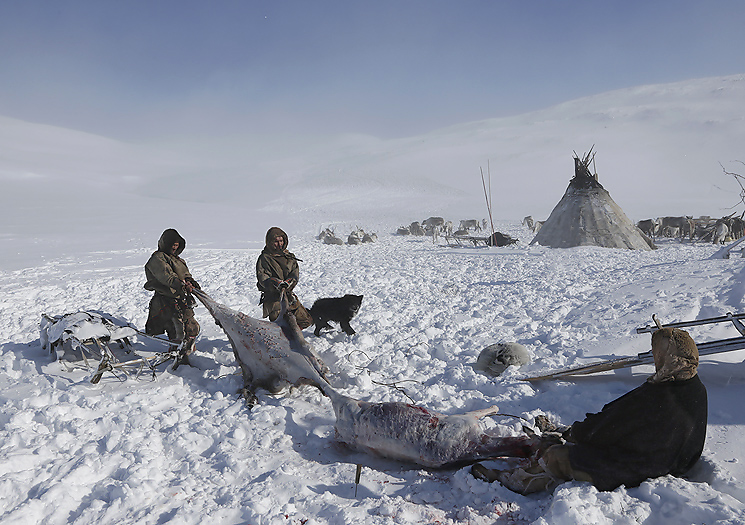
Strong Nenets pull the Fur off the newly killed Reindeer.
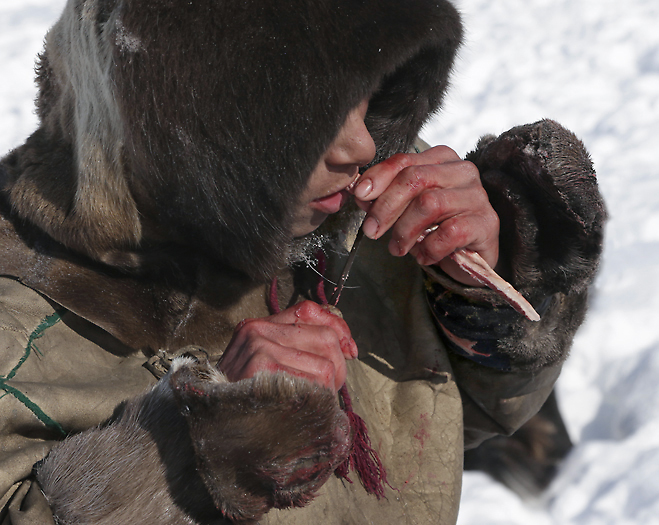
When a Reindeer is killed, the first to eat is Raw Marrow and warm Blood to drink.
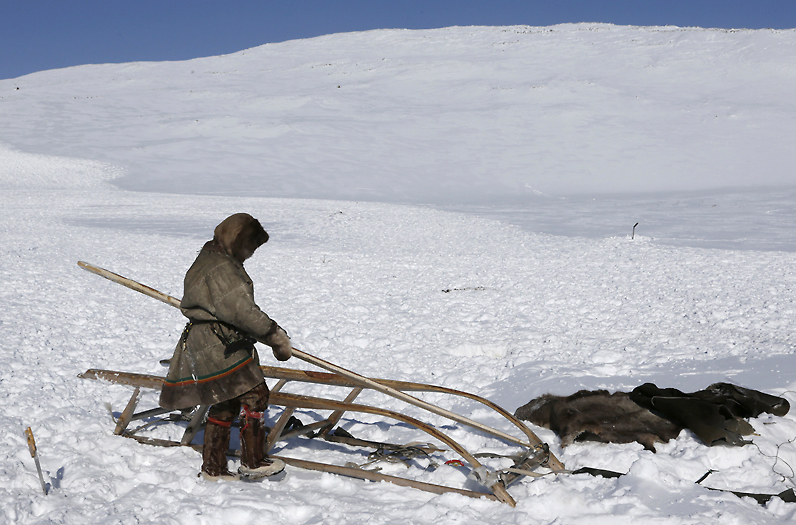
Maukyn make new Sledge Runner.
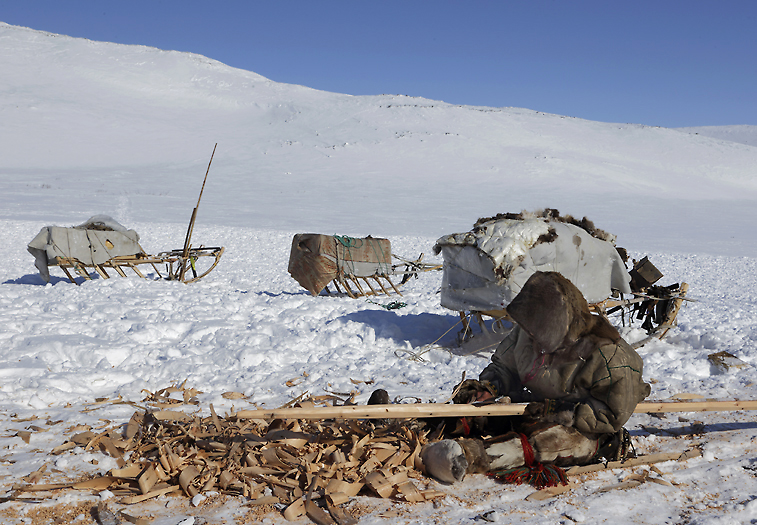
Efim make new Pole for the Chum.
Migrating with the reindeer herds in the Polar Ural mountains can be a challenge even for these tough people that have lived here since immemorial times. Deep snow, narrow valleys and hungry predators are some of the factors for this.
A cold and clear evening we are out traveling in this remote northern part of the Ural mountains we suddenly meet a group of Nenets that have lowered their chums, packed their belongings and need to move camp. We are high up in a mountain pass and was actually on our way “home”, but cancel our plans for the next hours to help making them ready to move on. The most effective way of helping is to join in and catch reindeer for pulling their sledges. The sun will disappear behind the mountains in a couple of hours, and we hurry up to prepare for their migrating. The travel leg can unfortunately not be especially long for them, -maximum 10km or so until they come to an area with pastures for the reindeer.
Four men with help from two of the women catch the reindeer effectively. They are harnessed up and ready to move around 21 o’clock, which is well in time before sunset. Nevertheless, they will have to start setting up camp close to the dark, and as this process take around 2 hours to do they will end up doing most of this work in the dark. I reckon this should be no problem for these hardy people.
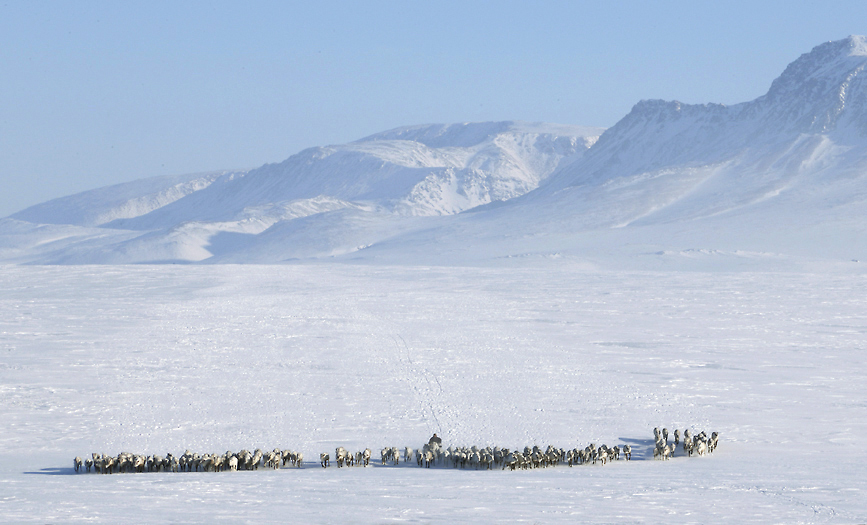
The Nenet Igor bring the Reindeer Herd down to the mountain pass using his Khasava-han (Nenet language for the men`s maneuverable sledge pulled by Reindeer).
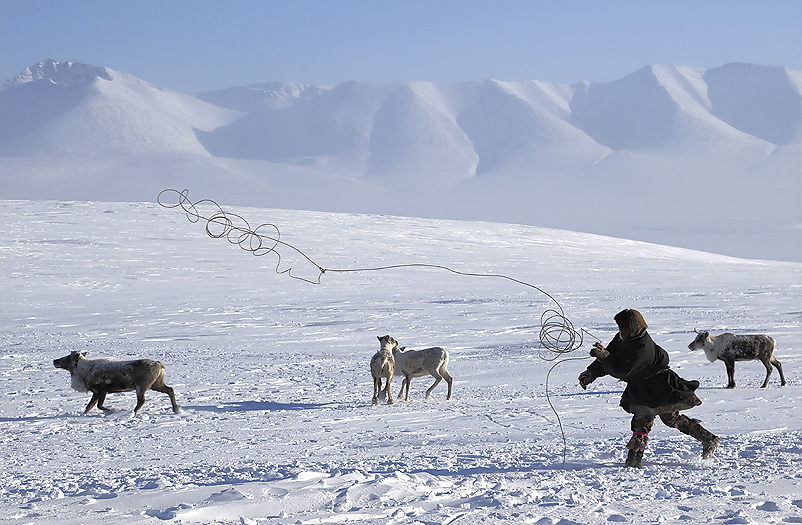
Nenet Alexey lassoing Reindeer from the arrived herd for pulling sledges later today.
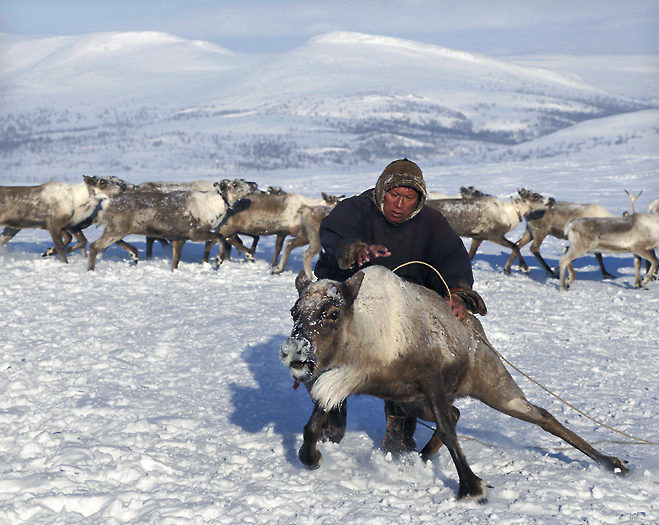
Igor grab the lassoed Reindeer and force it down to the ground.
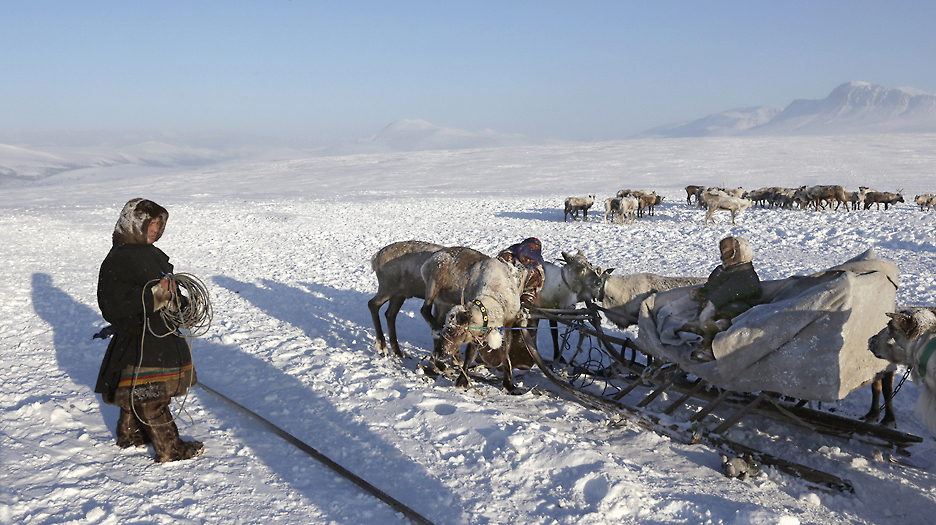
When the Pulling-Reindeer are connected to the sledges, Igor with wife and son make the last preparations before leaving the mountain pass with all their belongings.
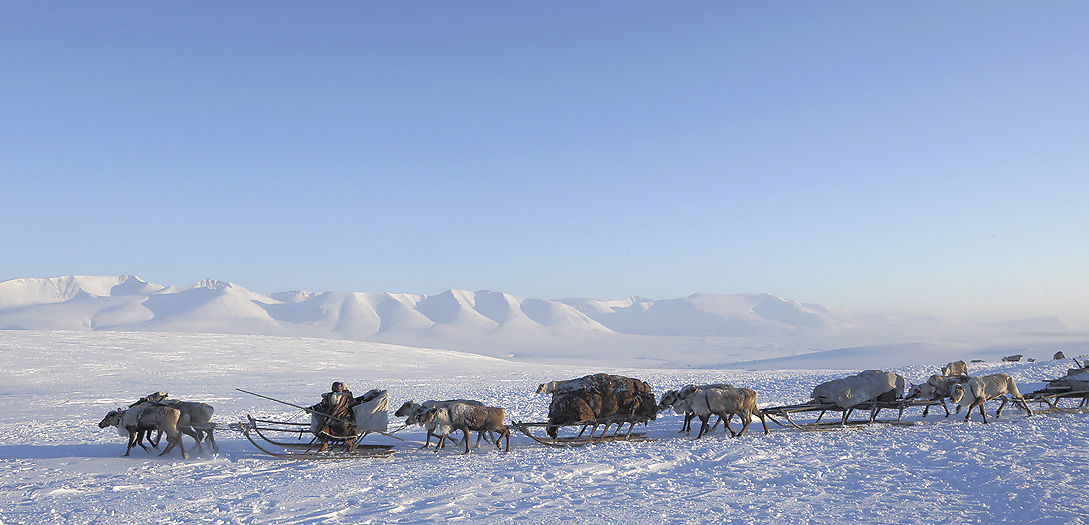
Part of the Caravan leaving the mountain pass.
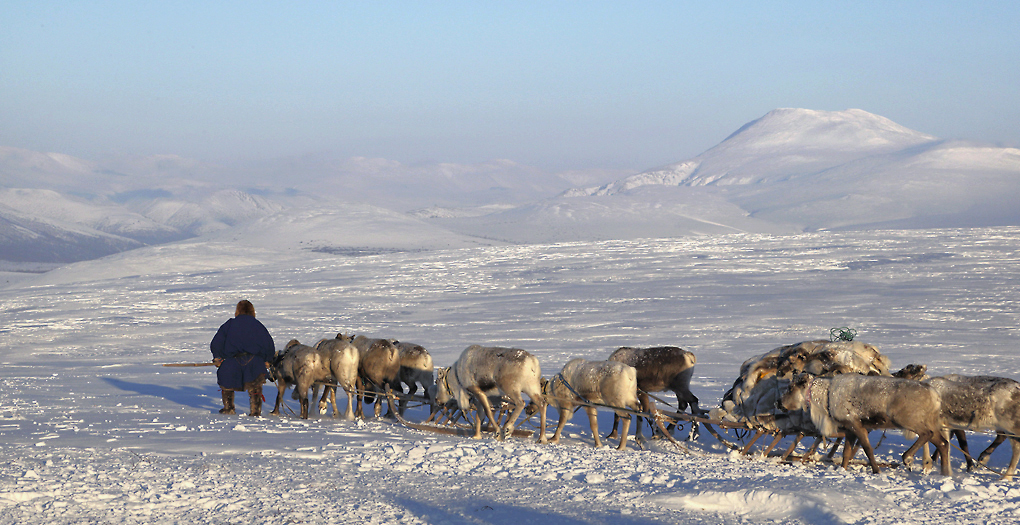
Alexey lead the Caravan further on in the Polar Ural mountains.
The days out in the wilderness here in western Siberia is slowly going to its end, and the caravan with migrating Nenets above is in fact the last I see to the Nenets in their world on my journey. It is a sight that I never will forget.
We will soon have to set course southwards to the abandoned military settlement of Polyarnyj and take the train back to the civilization.
Well arrived Polyarnyj we stay overnight in this strange settlement. Later the next day line up and wait beside the railway tracks for the eastbound train with destination Labytnangi. Hoping we are right about our knowledge about it’s time table, we are happy when we after a while hear the increasing noise from the trains diesel engine. The train stop after our waving, we jump in with our baggage and we can relax in the heated compartment.
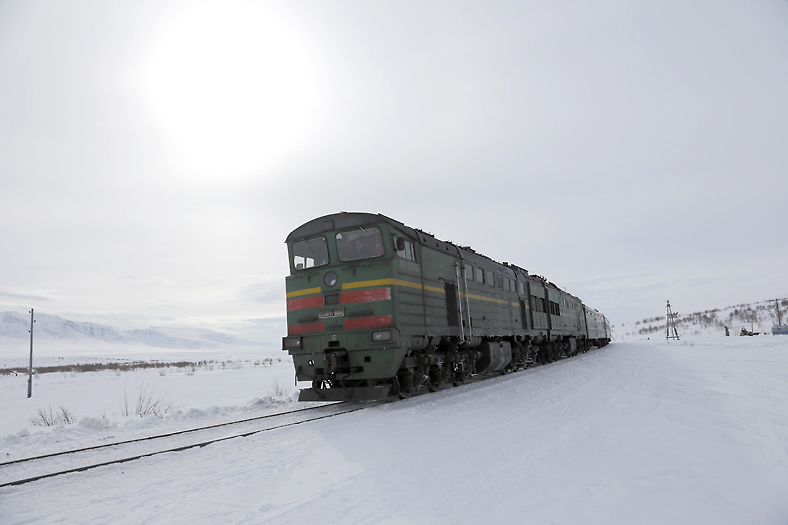
The train from Vorkuta stop to pick us up in the Polar Ural mountains.
An hour later we are in a lower valley and pass conifer trees on both sides. Further on we make a stop in the city of Kharp. This is one of the cities with penal colonies, where convicts are transported from other areas in Russia.
Here, and in many of the other places we have passed by on the journey in Yamalo Nenetsk autonomous okrug there have been several former Gulag Camps. Most of these camps are in decay, but some not. In of the closest, one can still see the gallows standing.
Also the Nenets were involved in the former Soviet Unions collectivization and many herders were enrolled in brigades. Many of them are still in the brigades (collectives) but more and more have private reindeer herds. The indigenous people north on the Bolsjezemeskaya tundra (N’arka ja) were never in contact with Russians and have always lived as they suited themselves. The latter is still the fact.
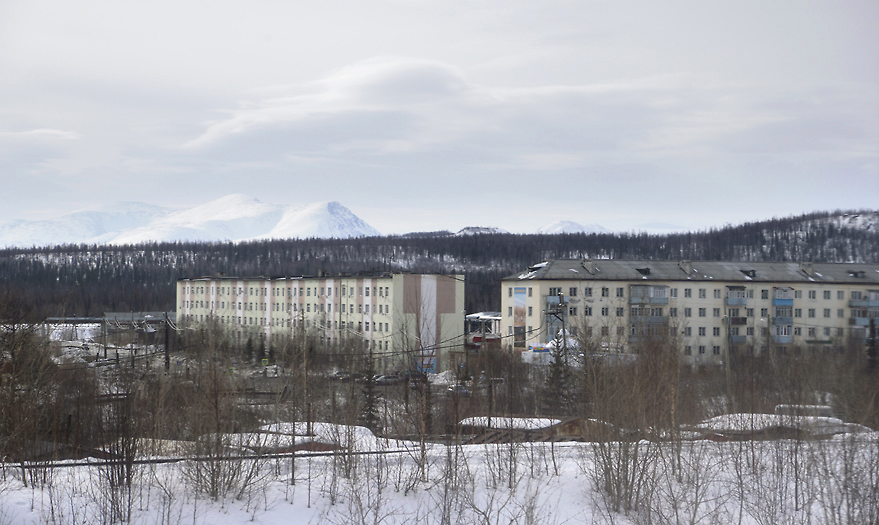
Part from Kharp. The Ural mountains behind.
After in total 6 train stops we finally arrives Labytnangi. The next day we cross the Ob river by car and arrive Salekhard airport. After checking in the baggage, we once again have to show the special permit to the security personnel. But where is the permit?I had in fact forgotten the whole permit, -and could not find it despite how much I searched. I was told by them that I had no chance of leaving the area if I could not show this piece of paper.
I searched and searched, but could still not find it. OK, – I began to realize that I perhaps would have to stay here a couple of weeks more until I managed to get a copy from the FSB of my original permit. The period I have been up here I have had a great time among the hospitable and interesting indigenous people, so spending additional time and learn even more of these people didn’t scare me totally of. So what now happens, -happens…
…and what really happened was that innermost in a pocket I suddenly found a small ball of paper with the heading разрешение доступа on it. 15 minutes later I sat in the plane southbound to Moscow.
NOTE ! For additional images of the Nenets (and other indigenous people) see the “People of the Land” gallery.
Per Michelsen
Thanks to:
Ed Vallance

